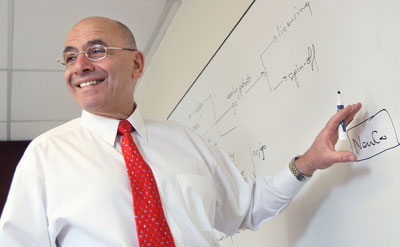
Michael Avedesian: tapping the commercial potential of ingenuity.
Owen Egan
Taking McGill to market
Office of Technology Transfer helps research reach the public
From basketball to Plexiglas to Dr. Wilder Penfield's legendary advances in the treatment of epilepsy and beyond, McGill University enjoys a rich heritage and reputation as a hub of discoveries both great and small.
Its ongoing mission to be Canada's foremost research-intensive, student-centred university is built on such innovation, but not all the inventions that arise from the work of McGill researchers become the stuff of legend, nor even see the light of day.
Those that do owe their success in part to the Office of Technology Transfer, whose mandate is to get McGill's breakthrough inventions out of the lab and onto the market.
"We're totally aligned with the mission of the University, ensuring that products and services that originated at McGill actually go on to be put to use in society for the public good," explained Dr. Michael Avedesian, a former private-sector executive now in his second year as interim director of the OTT.
With a research budget of over $500 million—largely subsidized through government and foundation grants—the OTT is responsible for commercializing intellectual property and negotiating contracts and licenses with industry partners on behalf of the University and its researchers.
Source of revenue
Now in its 16th year of operation, the OTT, tucked into a suite of off-campus offices on Peel Street, generates about $1.5 million a year in revenue for the University.
"This is a business office, not an academic office," Dr. Avedesian noted.
The OTT kicks into action whenever a McGill researcher makes a discovery thought to have commercial potential, such as a new technology or drug. There's no blinking red phone in Dr. Avedesian's office, but when he gets the call, he and his team waste no time in investigating what could be the next big invention.
"We have 90 days to perform due diligence to determine whether the invention can be commercialized," he said, adding the OTT weighs all inventions against three main criteria: its patentability, which is based on the extent to which the invention is novel, useful and "non-obvious"; the strength of the science behind the invention; and, ultimately, its commercial potential.
If the discovery fails to make the grade, the researcher is informed and is then free to take the invention elsewhere, perhaps using it as the genesis of his or her own start-up company.
If the invention gets the green light, McGill and the researcher agree to share equal ownership of the discovery, and the OTT begins the process of filing for patents. Then it's down to business.
No sure things
Commercializing the best of these inventions also entails assuming the risk—there's no guarantee that a given invention will generate significant revenue, or any at all.
The OTT files about 100 to 140 patent applications per year. Of the 129 Reports of Invention (ROIs) it investigated in 2005-2006, more than half pertained to discoveries in the health sciences: 40 percent from the Faculty of Medicine and 12 percent from McGill's hospital network. Another 21 percent was generated by the Faculty of Engineering, 16 percent came from the Faculty of Science, 7 percent from the Agricultural and Environmental Sciences, and 4 percent from other faculties.
Assuming responsibility of commercializing the best of these inventions also entails assuming the risk—there's no guarantee that a given invention will generate significant revenue, or any at all.
If it does, though, here's what happens:
One of the OTT's success stories is GeminX Biotechnologies, a developer of novel cancer therapeutics with facilities in Montreal and outside Philadelphia.
In this case, Dr. Philip Branton of McGill's Department of Biochemistry and Dr. Gordon Shore of the McGill Cancer Centre had been working separately until they began to view their individual research as complementary. They decided to work together and formed GeminX, which in 2005 raised $65.2 million in financing and moved its most advanced drug candidate, Obatoclax, into clinical trials.
"As a McGill spin-off 10 years ago, the OTT played a major role in getting GeminX off the ground," said Dr. Shore. "The willingness of a university to license intellectual property is crucial; none of this would have happened without that."
Another example is Molecular Biometrics LLC, a New Jersey-based developer of molecular and drug-based diagnostics that was four years in the making at McGill and was finally incorporated in 2006, said Dr. Avedesian. The company consolidates intellectual property emerging from the Faculty of Science, the Faculty of Agricultural and Environmental Science and the Lady Davis Institute of the Jewish General Hospital, a McGill Teaching Hospital. It also employs several McGill graduates at its recently opened Montreal subsidiary.
With 430 patents issued and 552 patents pending, the OTT manages the largest "patent estate" of any university in Canada, and though there have been no real blockbusters yet, Dr. Avedesian is convinced it's only a matter of time. "We're close," he said. How close? According to Dr. Avedesian, a mere matter of years, not decades.

